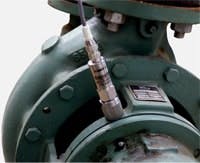Meggitt Sensing Systems' programmable PCH420V vibration sensor provides enhanced information about changes in machinery health eliminating additional infrastructure and cost. Plants utilizing HART networks can now monitor vibration through existing networks for continuous notification of potential failures or faults.
Meggitt’s new programmable transmitter allows vibration data to be accessed by HART enabled process controllers and information systems for better informed decisions and improved predictive diagnostic capabilities. Process control systems monitoring temperature, lubrication, and flow can now include vibration parameters for improved production efficiency and equipment reliability. PCH420V transmitters easily integrate with existing networks for quick visibility without the expense of additional infrastructure or cable networks. They are powered by the network for continuous coverage, unlike wireless solutions which only offer snapshots of asset performance and utilize batteries that require frequent replacement. Multi-drop installations enable up to 16 sensors to be monitored through a single address port.
The PCH420V superimposes digital communication on top of the popular 4-20 mA loop offering unparalleled flexibility for condition based maintenance of rotating equipment. Three user configurable bands allow targeted measurements to identify machine faults like unbalance, alignment, looseness or bearing wear conditions. Root cause analysis is enhanced as the cause of excessive vibration can be determined and appropriate process improvements can be implemented. Meggitt’s unique sensor-based filter banding offers unparalleled monitoring capabilities. Plant personnel can program filter band frequencies of installed sensors using HART enabled PLCs or handheld communicators.









